By Jeffrey A. Rendall, Photos By Jeffrey A. Rendall and Charles Rendall
|
|
BANDON, OR – “There’s nothing ‘style’ about this at all,” remarked Scottish Golf Architect David McLay Kidd, commenting on his first and only American design, Bandon Dunes, which resides at the resort of the same name along the cold and rugged coast of central Oregon.
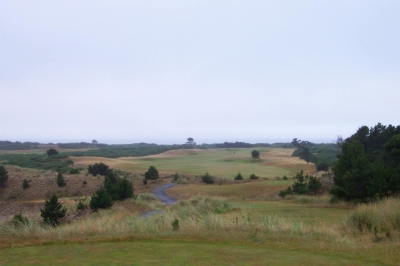 |
| Looking from the tee of the par five 3rd hole -- it'll take a good poke to reach the fairway... and if the wind's up, it's a daunting task. |
Perhaps a bit of explanation is necessary, as Kidd didn’t mean his golf course doesn’t have ‘style;’ it’s just that he objects to this type of golf being called ‘links-style,’ which is a common expression in America to describe any golf layout that doesn’t have many trees and is framed by fescue and dense vegetation, characteristic of what you’d see in the old country.
“In the first few months after Bandon’s opening, I was always quite amused to read journalists describing it as a ‘links-style’ golf course,” Kidd elaborated. “I would laugh and say ‘where are you getting this statement, ‘links-style’ course?’ It’s sitting on the coast, it’s covered in sand, we’re growing fescue – this isn’t links-style, this is links. This is it.”
No further explanation necessary, as Kidd’s right. Many a writer has described Bandon Dunes using this catchy and accepted terminology, myself included, only in the hopes of attempting to express what this thoroughly unique golf experience is truly like – because there’s no place on continental North America that’s really like it.
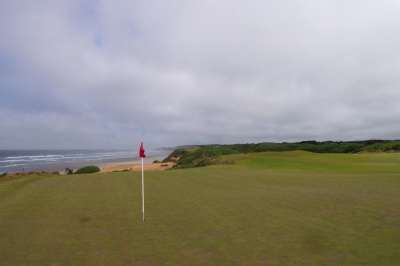 |
| From the green of the par four 16th -- a hole that's as strategic as it is beautiful. |
There are numerous examples of golf layouts in America that successfully mimic links golf, incorporating its elements – wind, tightly mowed grass, pot bunkers and fescue – but Bandon’s so authentic it even has gorse (not native to the area, but nobody seems to know exactly where it came from). For those unfamiliar with ‘real’ gorse, it’s a prickly holly-like shrub that grows prodigiously and is resistant to just about everything except hot weather.
It’s not something you’re craving to plant in your front yard, but if you want your golf course to look like Scotland or Ireland, then it’s handy to have around.
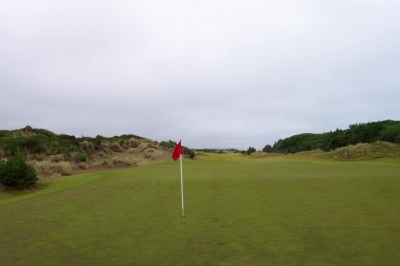 |
| The par four 5th hole is Bandon Dunes' #1 handicap hole. If the wind's in your face off the tee (as it often is), then it's most likely a three-shot hole to get there. |
Not only were the right setting conditions in place at Bandon, but the location also fit ‘real’ links’ secluded, almost mystic quality. Again, Kidd supplies the commentary: “I think the remote location of Bandon Dunes plays to its advantage. If you’ve ever read the book ‘Golf in the Kingdom,’ it talks about the bonding that men have on the golf course. And I think Bandon provides that exponentially better than any other golf course, maybe in the world.”
“Because of its remoteness, because of the unique experience, because you have to walk it, because you’re playing with a caddy, because you’re hitting these knock-down shots and putting from a hundred yards out… and you’re drinking wine and smoking cigars with your buddies. Whatever your thing is, it’s just an amazing place for golfers to bond – that camaraderie you can feel doesn’t quite exist anywhere else,” Kidd added.
“Even the trip in is special, with the little plane… the whole thing. And if it were parked next to San Francisco, it might not quite be the same,” Kidd said.
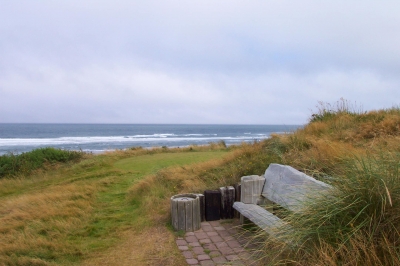 |
| Even the benches are natural at Bandon Dunes -- being carved from driftwood. |
All of it’s true. Bandon Dunes just may be the most difficult major golf destination to reach in the United States. There are four flights a day from Portland to a nearby small airport (yes, on ‘little’ airplanes), but it’s seven hours by car from Seattle, and about nine from San Francisco. You’ll invest some time to get here, so what you’ll find better be pretty special.
John Grothe, Bandon Dunes’ Director of Golf, said that ‘special’ was the idea all along. Grothe mentioned the Bandon concept was the brainchild of golf enthusiast Mike Keiser (of Recycled Greeting Cards fame), and it was largely driven by a purist’s vision of what golf was meant to be: “Bandon Dunes truly is a story of one man’s quest for a real American links-golf experience. He looked for the best links land in America, and those were his parameters – he didn’t care where it was.”
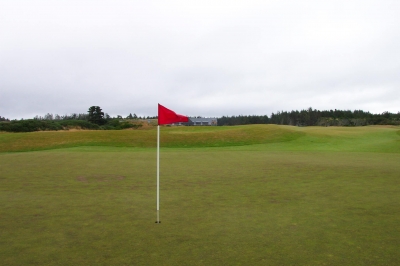 |
| On the 10th green you can glance back and see the clubouse. In true links 'style,' the two nines loop around in a figure-8, going out from the clubhouse and returning when you're done. |
Grothe continues, “He saw an opportunity to develop this great brand, of renaissance golf with links shots and walking-only, a return to the foundations and traditions of the game. He just happened to find this land along the coast here in Oregon. The original model for Bandon Dunes was that it would be open to the public and would simply be a place where people came to play golf – nothing elaborate, just a small little pro shop with a golf course. You’d have to drive down a dirt road and cross a bridge to get here, and arrive at this little A-frame building that didn’t have very much – maybe some golf balls and tees and small merchandise. Then you’d go out and play golf for as long as you like.”
And because of its remote location, Keiser’s financial expectations were as modest as his impressions of the golf facilities. They didn’t really know what to charge, so they initially decided on $100, with a replay rate of $50 in high season – and hoped to get 10,000 rounds a year out of the course, which would take care of its upkeep costs.
Then Bandon Dunes did over 25,000 rounds its first year (1999), and the owner’s plans changed a bit – but only to the extent that the experience could be enhanced, to the tune of two more golf courses (Pacific Dunes and the brand new Bandon Trails - they’re noteworthy too) and some resort accommodations. But no gaudy hotels or elaborate resort grounds with all the fixins’… when you come to Bandon, you’re there to play golf, and also do the other ‘bonding’ things that Kidd spoke of earlier.
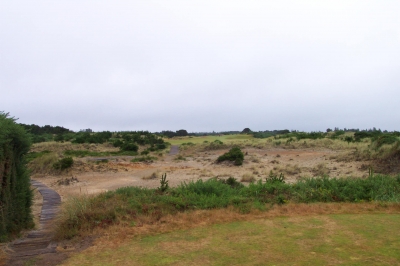 |
| This is what you see from the tee of the par four 7th. There's plenty of room in the fairway, but that won't necessarily lessen the intimidation factor. |
Kidd was instrumental in shaping the dream. Though Keiser’s blueprint was to create a pure links golf experience, it was the feisty Scotsman’s input and insistent personality that laid the groundwork for what was to come.
Kidd describes it: “I was very familiar with links golf along the west coast of Scotland, having grown up with it. And when I was contacted about the Bandon project, I thought maybe, in my naiveté that this rich American had kind of stumbled into me, or me into him – and albeit that the golf course was in about as remote a spot as you could find within the United States, maybe I could manage to sneak one (a design) in, you know?”
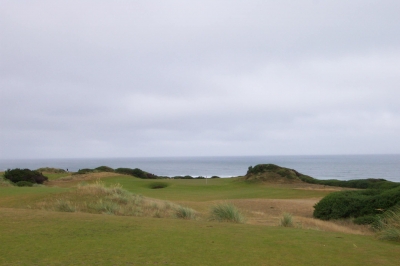 |
| The short par three 12th is a good example of the need to play links golf, as the best shot is to run it onto the green -- otherwise it'll roll all the way to the back. At least from there, you'll have a nice view of the ocean. |
“But I found out that Mike had actually done several other courses before and had worked with a number of other architects. Then I kind of felt dejected and thought, ‘well, I’m never going to get this job.’ I’m just a token Scotsman, a bit of entertainment to give him a certain Scottish twist and then he’ll go hire Tom Fazio or Pete Dye or some other big name – people I could only dream about meeting, much less compete against,” Kidd said.
Maybe it was Kidd’s background – having spent many a summer at the infamous Machrihanish Links (inspired by Old Tom Morris himself) that finally emboldened him to believe a foreigner in his mid-twenties could actually do what Keiser would want, and could help the owner realize just what that was, though the man with the land already had a pretty good idea.
“After I realized just how miniscule I actually was in this whole thing, I didn’t really feel a need to hold back when Mike asked me what I thought about the project,” Kidd remembers. “I said look, if you are going to build a proper links course, you know, not like this pseudo ‘links-style’ stuff that’s done in America, you’ll need to do it properly. That means you won’t have a bunch of homes out there, or a clubhouse sitting right on the water, or Americans driving around in carts everywhere.”
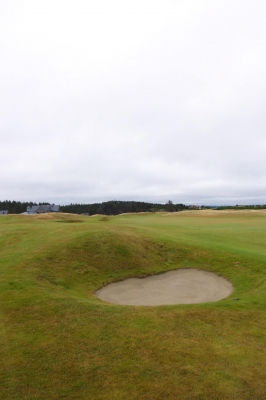 |
| Small pot bunkers dictate the strategy on many holes. They may not look like they're there for any particular reason, but the strategy is inherent -- being in one is most certainly a penalty. Here, in the fairway of the par five 9th hole. |
One can only imagine what it must’ve been like to have a brash young guy you’d met just an hour before with a funny thick Scottish accent telling you what you should be thinking about your American links concept, but Keiser was smart enough to listen.
“This would be golf as it truly was meant to be, with people walking, caddies carrying their bags and telling them how to hit these shots and playing off fescue and tight lies – you know, golf and nature. There were a few strange looks from some of the people who were hearing this, and I thought I’d blown it for sure. They patted me on the head and sent me on my merry way,” Kidd said.
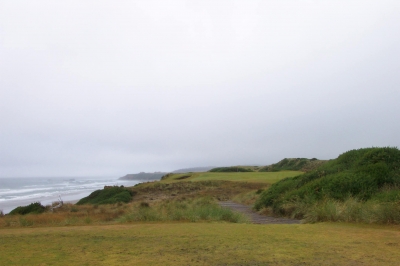 |
| Set high on the bluff is the par three 6th hole. The scorecard says it's only 161 yards from the back tees, but you might need a wood to reach it in the worst of conditions. |
Keiser called Kidd a few weeks later and commended him for his audaciously bold opinions, and affirmed that that’s what he’d been thinking all along. “I’d actually hit the button that maybe nobody else was finding – that Mike was completely up for creating something fairly unique within America,” Kidd confirmed.
Kidd, like all the architectural talent at Bandon Dunes, is eager to give nearly all the credit to Keiser, for his willingness to listen, and then bankroll a project that was highly conceptual and unproven. The resort’s success was hardly guaranteed, but Keiser’s pledge to provide a pure place to play golf was never in doubt.
Sure enough, lift up Bandon Dunes and transport it to the British Isles and it would fit right in. There’s another over-utilized saying that golf courses ‘fit’ the land they occupy, like they’d always been there, but for Bandon Dunes, that’s no hyperbole. Grothe says very little earth was moved, and a local crew built the course – and there was only one gentleman who’d ever been involved in constructing a golf course before.
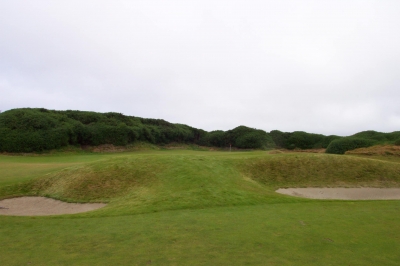 |
| In a course full of unique holes, the 14th really stands out, as it doglegs nearly 90 degrees from the tee and is protected by huge gorse shrubs all around it. It's prickly just looking at it. |
Kidd lived ‘on site,’ (in the town of Bandon) for eight months overseeing the process, and all those months later, there emerged a ‘real’ links golf course on American soil.
And people ate it up.
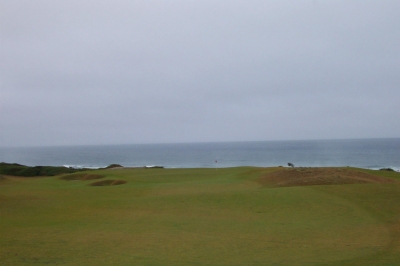 |
| Subtle and unassuming, the par four 4th hole demonstrates how wind and terrain dictate the shot, if you've got a favorable breeze, you might be able to go at the green from the tee. |
Today, the Bandon Dunes course plays the gentlest of the three layouts at the resort, despite being the longest in yardage. That is, it’s kindest off the tee. Kidd gets a bit sensitive when he’s asked about the width of the playing areas.
“The truth in making a resort golf course that’s enjoyable for everyone is pretty much universal – the only true way to do it is with width and size. Playable golf means width, so the average guy can stand on the tee, hit his slice and still find the ball,” Kidd lectured.
He adds, “I also knew just how bad the Bandon summer winds could be, and that worried me a little bit. I was scared that the winds in general could be more severe than Scottish winds, and I made the course overly wide to accommodate that. Certainly anybody playing in those summer winds – I’ve never heard anybody bitch about it being too wide in that circumstance.”
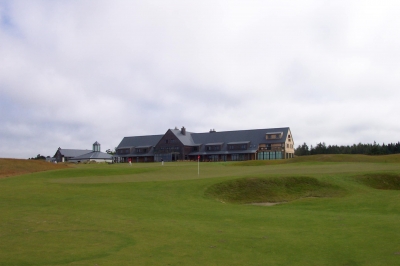 |
| Kidd got his wish, the clubhouse is not on the beach, but it still prominently overlooks the closing hole on the Bandon Dunes Course. |
Besides, the challenges in ‘real’ links golf are more subtle, as Grothe points out: “You may hit the ball in the middle of the fairway, and with a certain flag or wind, you’re still in the wrong spot. And people will say, ‘oh, I’ll just hit it up there and make a bogey.’ Well, they really thought themselves into the bogey and didn’t even realize it.
“It tricks you into thinking ‘oh this is fairly straightforward,’ but there’s this great subtleness. Bandon Dunes demands that you think your way around, much like the Old Course (St. Andrews) does. You might play the Old Course for the first time and say ‘What?’, then after about ten times you start to buy into it, you understand what’s going on. It’s the same for our course,” Grothe concluded.
It probably won’t take you more than once to appreciate Bandon Dunes for what it is – a true links course on Yankee soil. It’s one of a kind, and few would dare to think about trying to match it.
“A few years back, a group of writers asked me if I would’ve done anything different with the course if I had to do it over again,” Kidd said. “I was doing a seminar with Tom Doak (designer of Pacific Dunes), and I thought for a minute. I said ‘yeah, the one thing I’d do over again is to go second.’”
That’s a tribute to Doak’s work on the Pacific Dunes course (possibly the most visually stunning course you’ll ever see), but Bandon Dunes plays second fiddle to no one, lack of ‘style’ or not.
Note: Check the ‘details’ section below for notes on accommodations, meals and caddies.
Details:
The Bandon Dunes Course at Bandon Dunes Golf Resort
Website: http://www.bandondunesgolf.com/
Phone: (541) 347-4380; Toll Free (888) 345-6008
Designer: David McLay Kidd
Owner and Visionary: Mike Keiser
Director of Golf: John Grothe
Tees/Yardage/Slope/Rating
Black 6732 142/73.9
Green 6221 133/71.1
Gold 5716 122/69.6 (L) 134/74.9
Orange 5072 120/71.0
Rates and Notes:
Rates range from $70 - $175 (for hotel guests) and $90 - $225 (for non-hotel guests), depending on time of the year – and are also tied into packages based on hotel stays and duration of visit. Consult the website for further details.
Fees include all the range balls you’ll ever want, and access to Bandon Dunes’ 60-acre practice facility (designed by David McLay Kidd).
Carts not included! Pull carts are available, however (for no charge). We would not recommend anything other than carrying your bag or taking a caddy, however. All of Bandon’s courses are somewhat challenging to navigate, and the on-course marshals will keep you moving. They’ll switch over your huge cart/travel bag to a carrying bag upon request, and this is highly recommended. ‘Dragging’ the pull carts through the sand at Bandon Dunes is an ‘exercise’ in frustration as well as a thorough workout for your body. Not for the less than hearty.
We did not stay onsite, or try any of the restaurants (we stayed in town and enjoyed the local offerings when not golfing) – however, we heard good things about both, including from the wife of a playing partner. Bandon Dunes is not your ultimate family vacation (at least with young children), and that should be taken into account when booking a trip there. If you’re there to play golf, there’s hardly anything better in the world – but for non-golfers, the pickings are somewhat sparse.
Consult the website for more information on accommodations and possible alternative attractions.
The Bandon Dunes staff was first-rate – everything you’d expect for this type of ‘pure’ experience. The resort and its golf are not inexpensive, but you’ll feel there’s good value there.
| Related Links | Comments on this article? | |
|
Maryland National Golf Club Hollow Creek Golf Club Rocky Gap Resort PB Dye Golf Club in Ijamsville Whiskey Creek Golf Club |
E-mail Jeff Rendall, Editor: jrendall@golftheunitedstates.com |












